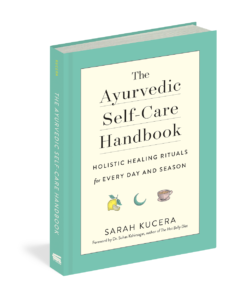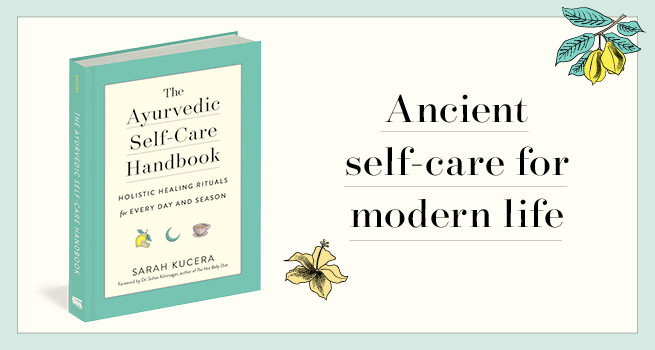 The need for self-care is at an all-time high these days. Between the endless news cycle, the constant notifications on our phones, stress from work, family, friends, and everything in between—its important to develop habits and rituals to help you feel better and achieve a little peace. And The Ayurvedic Self-Care Handbook is here to help.
The need for self-care is at an all-time high these days. Between the endless news cycle, the constant notifications on our phones, stress from work, family, friends, and everything in between—its important to develop habits and rituals to help you feel better and achieve a little peace. And The Ayurvedic Self-Care Handbook is here to help.
This authoritative guide to ancient healing offers more than 100 daily and seasonal Ayurvedic rituals—each taking 10 minutes or less—to reconnect you with nature’s rhythms, and to unlock better health. With Ayurveda, you can not only boost and stabilize your energy, but also undo physical and emotional distress, prevent and treat disease, and develop a deeper sense of mindfulness. Read on for an excerpt on Ayurvedic Healing Rituals, and how to find balance when you feel unwell—and don’t forget to pick up a copy of the book, available now!
***
We are instinctively drawn to natural medicines, such as Ayurveda, because of the system’s willingness to see things holistically instead of in parts. There’s an understanding that symptoms are often related and that the entire being should be evaluated and treated. For every illness, there is a story, and healing is much more than taking a pill or a tablet to feel better, even if that pill or tablet is natural. Herbal therapies, and sometimes even pharmaceuticals, can be a necessary support on your quest to feel better. But to get better and stay better, you must consider how you got to this point in the first place and the lifestyle changes needed to turn things around.
As we learned in chapter 10, there are degrees to which imbalances and illness can be manifested. There are our smaller daily, or seasonal imbalances that come from a hiccup in our routine or diet. With a little conscious work, as quickly as these arise, they heal. Then, there are the more deeply seated illnesses that are an accumulation of unresolved issues and took more time to develop. These take more patience and time to heal.
In my practice as an Ayurvedic practitioner, I see a range of people with varying health concerns. There are those who want to learn more about Ayurveda as a way to enhance their already good health, people who are dealing with minimal symptoms, and those who have come to me as a last resort because nothing else has given them the relief that they seek. In all cases, no matter their severity, we address their daily routine and rituals. Without this as a foundation, superficial changes, including herbs and diet, won’t have the same capabilities to heal, and often the source of the problem is never revealed or addressed.
The following is a list of conditions I chose based on my experiences in clinical practice. They are the most common conditions I see that are caused by or complicated by sporadic scheduling or misalignment with nature’s rhythms. Patients with these conditions have had a positive response to resetting their lives with rituals, and are often surprised by how powerfully a commitment to consistency can improve how they feel. For each condition, there is an Ayurvedic explanation that uses the doshas, elements, and gunas. You’ll find this to be a fresh perspective and a way to simplify conditions that feel complex. Even if you feel well and aren’t experiencing any of these conditions, reading through them will be an educational tool; you may even notice that you have symptoms but weren’t fully aware of them. This will deepen your understanding of Ayurveda and serve as a preventive source of inspiration, to help you identify potential imbalances before you become symptomatic.

Adrenal Fatigue
Adrenal fatigue is a condition caused by chronic stress, something that has come to define modern Western culture. It happens when you are testing your limits by participating in more than you really have energy to sustain. You are either going so fast that you don’t notice the signs of not feeling well, or you decidedly push through them. This results in a chronic stimulation of your sympathetic nervous system (fight or flight) without the balance of your parasympathetic nervous system (rest and digest). What should be a natural ebb and flow turns into an elevated baseline where your body is always prepping for survival.
Your adrenal glands do their best to regulate the production of stress hormones such as adrenaline and cortisol, but eventually even they get tired and can’t keep up. You start to experience symptoms like extreme fatigue, salt cravings, anxiety, depression, and difficulty managing minorly stressful situations. It becomes more complicated when your body perceives itself to be in survival mode and uses energy for functions needed to stay alive, at the expense of otherse that aren’t immediately needed, such as reproduction. In other words, if you’re being chased by a bear the ability to conceive isn’t a priority; energy that would otherwise be spent regulating reproductive hormones gets redirected to regulating respiration and heart rate. When you reach this point, the stress you’ve experienced has been accumulating for so long that your body can’t recover unless a change is made.
The solution is always to slow down and choose rejuvenation over stimulation. But often the lifestyle that leads to adrenal fatigue in the first place won’t allow the time for restoration. The answer then lies in the ability to give your energy a container. Those who are vulnerable to adrenal fatigue are like a garden hose turned on high without anyone holding on to it: The energy is flying all over the place, on the ground and in the air. When this happens to us physiologically and psychologically, we need to create structure and organization around our day to contain our energy and let us control where to use it.
The rituals for adrenal fatigue are specially designed to take a minimal amount of time and effort while giving your nervous system an impactful and much-needed break. Emphasis should be placed on being consistent and present, so that you can be more aware of how you feel and notice when it is time to pause before you get too overloaded.
DAILY ENERGY BUDGET (5 MINUTES)
Take three to five minutes to write out your daily energy budget. This is a chance to become conscious of your energy reserves, and to become well versed in the art of letting go. These prompts are designed to help you wisely budget your energy for the day. You can keep them in a journal, or write them on a piece of paper to keep in your pocket as a reminder. Creating a note on your phone can also be helpful, but avoid this step if you are easily distracted by digital devices.
I will allow space in my energy budget today to:
________________________________________________________________________ .
Example: I will allow space in my energy budget today to: take a midafternoon walk outside.
Being conscious of my energy use is important because:
________________________________________________________________________ .
Example: Being conscious of my energy use is important because: my desire to give energy to others can’t be fulfilled unless I have energy myself.

Anxiety
Anxiety can be described as a condition of worry, concern, or nervousness, which Ayurveda attributes to an increase in vata dosha or an accumulation of the ether and air elements. Anxiety can take on many forms and everyone experiences this condition in their own unique way. Still, the unsettled feeling, disruption, tension, and jitters that accompany the condition for many could be assigned vata’s descriptive words, like light, hard, and mobile.
Because no person’s condition stems from a single cause, the Ayurvedic approach asks you to review your personal circumstances and to look for the influx of ether and air properties in your life. Trauma, surgery, loss of a job, change of career, a new home, a sporadic schedule, or a diet laden with raw food, dry food, cold food, or carbonated drinks can all contribute to such a state.
Practices that provide grounding, structure, and comfort will lead you to your equilibrium. These rituals are meant for situational feelings of anxiety or the cases that arise with unexpected situations or rough patches, like when you’re interviewing for a job or meeting your significant other’s parents. If you have a propensity for anxiety, incorporating these rituals will help you reduce and manage future cases. And while any degree of anxiety can warrant a trip to your therapist or counselor, always seek out professional intervention for conditions that are longer-lasting or more severe.
QUIET TIME FOR ROOTING DOWN (5 MINUTES)
Imagine how it feels to have someone place their hand on your shoulder, or take a moment to place your own hand on the top of your head. Notice how the minimal weight evokes a settled feeling. Heaviness counters light emotions like anxiety, which theoretically could be why your body holds on to weight, despite concerted efforts to exercise, under times of busyness or stress—to anchor and prepare yourself if danger arrives.
While your normal meditation practice could serve up something similar, this special quiet time uses weight to help with the practice of rooting down. Set a timer for three to five minutes, or longer if allowed. Lie on your back on the floor, or sit fully upright. Drape a heavy blanket, bolster, or sandbag horizontally across your pelvis or thighs. Rest comfortably with your hands on your thighs over the prop, palms face down, to encourage even more sinking in.

Weakened Immunity or Low Ojas
We all know that a strong immune system is important for staying healthy, especially in times of stress. Ojas is our vitality or an essence, that is very similar to our immunity. It’s what makes someone radiant glowingand keeps them in good health, so that they can pursue the things in life that make them thrive. Our ojas can become low if we don’t get enough sleep, have weak digestion, eat poorly, work too much, or don’t allow time for people and things that feed our soul. During those times, we are more susceptible to illnesses. Note that adrenal fatigue (page 163) and burnout (page 182) are two conditions of low ojas.
When I was fifteen, I had a moped so I could navigate around my small town without having to rely on my parents. It had two fuel tanks: a main tank and a reserve tank. If I got low on fuel, I could flip a switch from main to reserve to help get me to the nearest gas station. Ojas is like this reserve tank. You want to keep it full in case there is an emergency, but better if you can get along without using it. Signs of lowered immunity or low ojas can appear before your main fuel tank is empty, but longer recovery is needed if you’ve gone through your primary fuel source and started depleting your energy stores.
Ojas can be rebuilt through specific herbs and foods, spending time with loved ones, regular abhyanga, and resting. Thus, even though there may be various reasons that your immunity and vitality have decreased, we can follow a common path to restoration. In these rituals you’ll see a general theme for resting and slowing down, with an overall focus on rebuilding.
MEDITATION FOR RESTORING AND REBUILDING (5 MINUTES)
Your thoughts may be your strongest asset for restoration. Use this meditation to create an inner framework that supports you in rebuilding your immunity and ojas. This meditation can be practiced seated with your palms facing up, or you can try it standing in what feels like a power stance, by placing your feet slightly wider than your hips, bending your knees slightly, and holding your hands palms-up at your sides. Close your eyes and begin to breathe deeply, using a slow and methodical breath. Now, bring attention to an area of your life where you have felt weak or inadequate. What are the descriptors of this? Is it that you feel financially unstable, underprepared for your job, or just not enough? Create a mantra by using one to three sentences that represent you being strong in these aspects, such as, “My life is abundant. I am ready for what may come. I am enough.” Repeat these phrases to yourself, imagining your evolution in these areas, going from weak to strong. After three to five minutes, slowly open your eyes and see things from your new perspective.
***
Excerpt from The Ayurvedic Self-Care Handbook: Holistic Healing Rituals for Every Day and Season.
Copyright © 2019 by Sarah Kucera.



